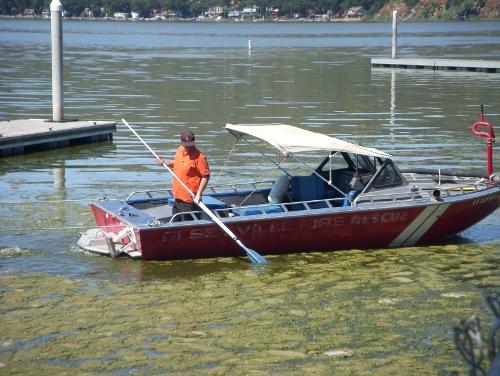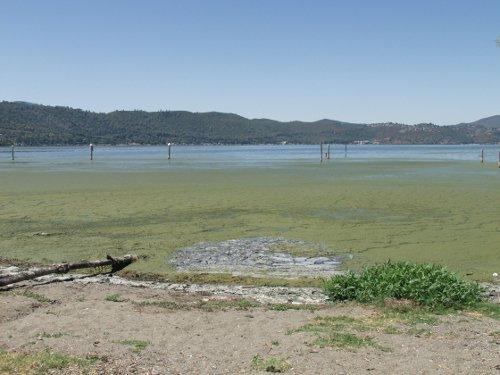
CLEARLAKE – State and local officials met on Monday to begin brainstorming about ways to address the returning problem of algae mats on Clear Lake.
Over the last three weeks area residents have reported that thick algae mats similar to those that plagued the lake and the community last summer are showing up again.
That resulted in a visit from Assemblyman Wes Chesbro – who had reportedly received numerous calls from unhappy county residents. He met with county and city leaders and then took a tour of the lake Monday morning.
While the algae situation is not yet to the extent it was this time last year – county Water Resources officials said earlier this month that the numbers of troublesome blue-green algae cells per liter are far less now than they were at this point in 2009 – the problem is leading to mounting public concern.
The city of Clearlake appears to be getting hit hard due to a mere fact of nature – Water Resources reported that the county's winds blow the algae down into the southern reaches of the lake, where it tends to collect against seawalls and beaches.
That phenomenon was in evidence on Monday at the city's swim beach at Austin Park, which was socked in by several yards of thick, unpleasant-smelling green algae mats. There, Chesbro and the local officials talked with local residents and heard their complaints.
Just down the road, at Redbud Park, a city water truck was washing down one of the boat ramps, which was clogged and coated with algae.
At the same time a city staffer in the old Kelseyville Fire boat, purchased last year by the county, was running the boat's engine to try to break up the mats, which were thick enough to support birds and stray soda cans. County Supervisor Jeff Smith said the boat is on loan to the city for algae duty.
Before making their way out to Austin Park, Chesbro and his field representative Ruth Valenzuela had an hour-long, closed-door meeting with Smith, Clearlake Mayor Judy Thein, Supervisor Denise Rushing, County Administrative Officer Kelly Cox, county Water Resources Director Scott DeLeon and Greg Giusti, a UC Cooperative Extension advisor and chair of the county's Fish and Wildlife Advisory Committee and Invasive Species Council.
“We talked about the condition of the algae,” said Thein.
They considered long-term and short-term solutions, such as installing floating islands like Clearlake Oaks is doing, reintroducing the Clear Lake Hitch and looking at Klamath Lake, which reportedly has algae issues, Thein said.
Clarity, light and nutrients were discussed as possible contributing factors, she explained.
“It was educational for all of us,” she said.
She added, however, that nothing was decided.
“We're just throwing ideas out there right now,” Thein said.
Thein said Chesbro told them he had received numerous calls about the problem, and pledged to look for funds to help the community.
Last year the county received a $100,000 state cleanup and abatement grant to work on algae mitigation, and $38,000 was spent on a new air boat, said Smith. The new boat was to have arrived by Monday.
Smith said he took Chesbro out for about an hour on a county air boat, showing him areas of heavy matting near Sunset Resort and places where new algae is drifting in. Along the way, they came upon a large mass out in the lake that Smith hadn't seen before.
Besides the algae, there also are weeds this year, Smith said.

“It's a real mess with the weeds and the algae,” he added.
Last Thursday Smith said he helped pull six to eight loads of the algae away from Clearlake beaches, using booms to drag it out behind the air boat, which can get into places that other boats can't. He said he took it into the middle of the lake where he and others ran over it with boats so it would sink.
Chesbro noted that it was “a real eye opener” for him, Smith said.
Smith said he doesn't see the “bubbling up” with this blue green algae that he saw with the lyngbya variety of blue green algae last year, so he doesn't believe it's the same stuff.
Neither does Dennis Krentz of the Clearlake Keys Property Owners Association, which is doing battle with blue green algae once again this year.
Krentz said it appears to be a different variety of blue green algae that's slightly easier to deal with than lyngbya, but presents a problem because there's so much of it.
He said they saw the first onslaught about three weeks ago, later than last year's problems began. This year, differing wind patterns are causing problems in different areas of the Keys.
The association is applying for county permits in order to allow for a trial testing of low impact chemicals that a company is going to try on the harder hit areas, he said.
Their spray boats are having little impact because of the mats' thickness, Krentz explained, so they're planning to run a weed harvester through the areas where the algae is most dense in an attempt to break it up and sink it.
Noting the association is a volunteer organization, Krentz said, “The volunteers are stepping up pretty good.”
They have five boats in action, but Krentz added, “We don't know how successful we are going to be given the magnitude of the problem.”
After receiving a call from Lake County News, Clear Lake expert Dr. Harry Lyons took a water sample in Jago Bay on Monday evening and was able to confirm that, at least in that area, lyngbya was the predominant algae.
He said he also found other blue greens like microcystis and gloetrichia mixed in to lesser degrees.
Lyons said he's not yet seen the caking like he saw last year, but added, “give it time.”
As he had noted in a presentation on the lake earlier this month, Lyons urged people to think about global solutions, and to approach the algae problem from a strategic point of view.
However, he warned, taking the strategic approach won't be quick, but likely will be a 40-year process with lots of bumps – with each bump being a regime change.
“That's what I fear we're witnessing” – a regime change, said Lyons, with lyngbya becoming the dominant regime.
He said he's unwilling to offer predictions, noting, “The lake is very unpredictable.”
Strategy is slow, and tactics are limited by funds, which he noted is frustrating “because our efforts are puny and the lake is so big.”
He added, “This is not something that lends itself to a quick solution. It's a big, long, difficult problem.”
E-mail Elizabeth Larson at This email address is being protected from spambots. You need JavaScript enabled to view it. . Follow Lake County News on Twitter at http://twitter.com/LakeCoNews and on Facebook at http://www.facebook.com/pages/Lake-County-News/143156775604?ref=mf .